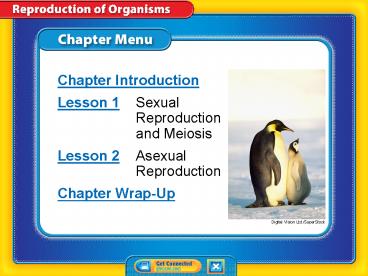Chapter Menu - PowerPoint PPT Presentation
Title:
Chapter Menu
Description:
Chapter Introduction Lesson 1 Sexual Reproduction and Meiosis Lesson 2 Asexual Reproduction Chapter Wrap-Up Digital Vision Ltd./SuperStock Chapter Menu – PowerPoint PPT presentation
Number of Views:120
Avg rating:3.0/5.0
Title: Chapter Menu
1
Chapter Menu
Chapter Introduction Lesson 1 Sexual
Reproduction and Meiosis Lesson 2 Asexual
Reproduction Chapter Wrap-Up
Digital Vision Ltd./SuperStock
2
Chapter Introduction
Why do living things reproduce?
3
Lesson 1 Reading Guide
Sexual Reproduction and Meiosis
- What is sexual reproduction, and why is it
beneficial? - What is the order of the phases of meiosis, and
what happens during each phase? - Why is meiosis important?
4
Lesson 1 Reading Guide - Vocab
Sexual Reproduction and Meiosis
- sexual reproduction
- egg
- sperm
- fertilization
- zygote
- diploid
- homologous chromosomes
- haploid
- meiosis
5
Lesson 1
What is sexual reproduction?
- Sexual reproduction is a type of reproduction in
which the genetic materials from two different
cells combine, producing an offspring. - The female sex cell, an egg, forms in an ovary.
- The male sex cell, a sperm, forms in the testis.
6
Lesson 1
What is sexual reproduction? (cont.)
During a process called fertilization, an egg
cell and a sperm cell join together to create a
zygote.
7
Lesson 1
Diploid Cells
- Organisms that reproduce sexually form body cells
and sex cells. - In body cells of most organisms, similar
chromosomes occur in pairs. - Diploid cells are cells that have pairs of
chromosomes.
8
Lesson 1
Diploid Cells (cont.)
- Pairs of chromosomes that have genes for the same
traits arranged in the same order are called
homologous chromosomes. - Because one chromosome is inherited from each
parent, the chromosomes are not identical. - Different organisms have different numbers of
chromosomes.
9
Lesson 1
10
Lesson 1
Haploid Cells
- Haploid cells are cells that have only one
chromosome from each pair of chromosomes.
haploid from Greek haploeides, means single
11
Lesson 1
Haploid Cells (cont.)
- In meiosis, one diploid cell divides and makes
four haploid sex cells. - Meiosis occurs only during the formation of sex
cells. - Meiosis involves two divisions of the nucleus,
meiosis I and meiosis II. - A reproductive cell goes through interphase
before beginning meiosis I.
12
Lesson 1
Why is meiosis important?
- Meiosis forms sex cells with the correct haploid
number of chromosomes. - Meiosis also creates genetic variation by
producing haploid cells. - When haploid sex cells join together during
fertilization, they make a diploid zygote, or
fertilized egg.
13
Lesson 1
Why is meiosis important? (cont.)
- The fertilized egg, formed when sex cells join
together, divides by mitosis to create a diploid
organism.
14
Lesson 1
Why is meiosis important? (cont.)
Why is meiosis important?
15
Lesson 1
How do mitosis and meiosis differ?
- During mitosis and cell division, a body cell and
its nucleus divide once and produce two identical
cells. - The two daughter cells produced by mitosis and
cell division have the same genetic
information.
16
Lesson 1
How do mitosis and meiosis differ? (cont.)
- During meiosis, a reproductive cell and its
nucleus divide twice and produce four cellstwo
pairs of identical haploid cells. - Meiosis forms sex cells used for sexual
reproduction.
17
Lesson 1
18
Lesson 1
Advantages of Sexual Reproduction
- Genetic variation occurs in all organisms that
reproduce sexually. - Due to genetic variation, individuals within a
population have slight differences.
19
Lesson 1
Advantages of Sexual Reproduction (cont.)
- Genetic variation may enable one plant to be more
disease-resistant than another within the same
species.
20
Lesson 1
Advantages of Sexual Reproduction (cont.)
- Selective breeding has been used to develop many
types of plants and animals with desirable traits.
Ingram Publishing/SuperStock
Stockbyte/Getty Images
Medioimages/PunchStock
image100/SuperStock
Wally Eberhart/Visuals Unlimited/Getty Images
21
Lesson 1
Advantages of Sexual Reproduction (cont.)
Why is sexual reproduction beneficial?
22
Lesson 1
Disadvantages of Sexual Reproduction
- Organisms have to grow and develop until they are
mature enough to produce sex cells. - Organisms must form sex cellseither eggs or
sperm.
23
Lesson 1
- Fertilization occurs when an egg cell and a sperm
cell join together.
24
Lesson 1
- Organisms produce sex cells through meiosis.
25
Lesson 1
- Sexual reproduction results in genetic variation
among individuals.
Digital Vision Ltd./SuperStock
26
Lesson 1
Cells that have pairs of chromosomes are called
____.
A. chromosomes B. body cells C. diploid
cells D. sex cells
27
Lesson 1
During which process does one diploid cell divide
and make four haploid sex cells?
A. osmosis B. fertilization C. reproduction D. mei
osis
28
Lesson 1
Do you agree or disagree?
- 1. Humans produce two types of cells body cells
and sex cells. - 2. Environmental factors can cause variation
among individuals. - 3. Two parents always produce the best offspring.































